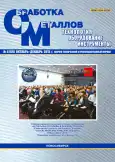Stainless austenitic chrome-nickel steels possess low strength properties, which are not improved by heat treatment. Surface hardening treatments through deformation (ultrasonic impact, shot peening etc.) often cannot provide high quality of the worked surface. Therefore, the primary task is to form and improve the methods of finishing treatments providing both effective deformation hardening and high quality surface of austenitic steels. It has great importance for precision parts of tribological components. The influence of frictional treatment by hemispheric synthetic diamond indenter on phase composition, structure, micromechanical and tribological characteristics of metastable austenitic 12Kh18N10T steel (in wt.%: 0,10 С; 17,72 Cr; 10,04 Ni; 0,63 Ti; 1,33 Mn; 0,57 Si; 0,227 Mo; 0,064 Co; 0,014 Nb; 0,057 Cu; 0,031 P; 0,014 S and Fe for balance) surface layers is studied. Roughness of the worked surface is studied through an optical profilometer. Methods of transmission electron microscopy and X-ray analysis are applied for investigation of steel structure and phase composition. Micromechanical properties are determined by measuring of microhardness by the recovered indentation method and using microindentation technique. Tribological properties (wear intensity and coefficient of friction) are determined upon sliding friction in the air conditions in the «steel 12Kh18N10T - steel 45 (0,45 wt. % of С; hardness is 50 HRC)» friction couple. It is established that frictional treatment of austenitic steel forms qualitative surface with low value of roughness parameter (Ra≈100 nm). At that, nanocrystalline and fragmented submicrocrystalline martensitic-austenitic structures in surface layer are arisen, high level of surface hardening (710 HV0.025) as well as essential decrease of wear rate and friction coefficient under conditions of dry sliding friction is achieved. The revealed leap of tribological properties of the austenitic steel at the initial stage of friction is connected with a limitation of seizure processes development on the nanostructured surface and a change of wear mode - from seizure to plastic edging. The use of kinetic microindentation method for analysis of increased resistance of nanostructured layer with martensitic-austenitic structure to plastic deformation under adhesive wear is justified.
 6-17
6-17


 18-30
18-30


 31-42
31-42


 43-50
43-50


 51-60
51-60


 61-71
61-71


 72-79
72-79


 80-92
80-92


 93-101
93-101


 102-112
102-112







